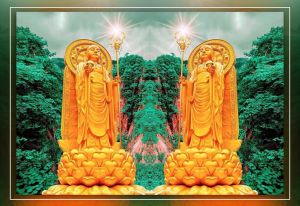Prayer to the Gurus of the Dzogchen Lineage
༄༅། །རྫོགས་ཆེན་བླ་བརྒྱུད་གསོལ་འདེབས་བཞུགས།
Prayer to the Gurus of the Dzogchen Lineage
by Dodrupchen Jigme Tenpe Nyima
ཨེ་མ་ཧོ། །
emaho
Emaho!
རང་རིག་སྤྲོས་བྲལ་ཆོས་སྐུ་ཀུན་ཏུ་བཟང་། །
rangrig trödral chöku kuntuzang
My very own pure awareness, dharmakāya Samantabhadra,
ལྷུན་གྲུབ་འགགས་མེད་ལོངས་སྐུ་རྡོ་རྗེ་སེམས། །
lhündrub gakmé longku dorjé sem
Spontaneously perfect and unceasing, saṃbhogakāya Vajrasattva,
ཟུང་འཇུག་སྤྲུལ་པའི་རྣམ་རོལ་དགའ་རབ་རྗེ། །
zungjuk trulpé namrol garab jé
Manifest display of indivisible unity, Lord Garab Dorje—
སྐུ་གསུམ་བླ་མ་རྣམས་ལ་གསོལ་བ་འདེབས། །
ku sum lama nam la solwa deb
To these gurus of the three kāyas, I pray!
རྫོགས་ཆེན་བསྟན་པའི་མངའ་བདག་འཇམ་དཔལ་བཤེས། །
dzogchen tenpé ngadak jampal shé
Sovereign of the Dzogchen teachings, Mañjuśrīmitra,
གྲུབ་གཉིས་ནོར་གྱི་བང་མཛོད་ཤྲཱི་སིང་། །
drub nyi nor gyi bangdzö shiri sing
Treasury of the two kinds of attainment, Śrī Siṃha,
རབ་འབྱམས་རྒྱལ་བའི་སྤྱི་གཟུགས་པདྨ་འབྱུང་། །
rabjam gyalwé chizuk pema jung
Embodiment of infinite victorious buddhas, Padmākara—
མཚུངས་བྲལ་བླ་མ་རྣམས་ལ་གསོལ་བ་འདེབས། །
tsungdral lama nam la solwa deb
To these incomparable gurus, I pray!
ཐུབ་བསྟན་ཉིན་མོར་བྱེད་པོ་ཀུན་མཁྱེན་རྗེ། །
tubten nyinmor jepo künkhyen jé
Sun of the Buddha’s teachings, omniscient Longchenpa,
རིག་འཛིན་ཡོངས་ཀྱི་སྤྱི་རྗེ་འཇིགས་མེད་གླིང་། །
rigdzin yong kyi chi jé jikme ling
Lord of all vidyādharas, Jigme Lingpa,
དམ་ཆོས་མི་ནུབ་རྒྱལ་མཚན་བོ་དྷིའི་མཚན། །
damchö mi nub gyaltsen bodhi tsen
Unwaning victory banner of the sacred Dharma, with the name of Bodhi—1
རིག་འཛིན་བླ་མ་རྣམས་ལ་གསོལ་བ་འདེབས། །
rikdzin lama nam la solwa deb
To these vidyādhara gurus, I pray!
ཟླ་མེད་རྒྱལ་བ་གཉིས་པ་ཛྙཱ་ནའི་ཞབས། །
damé gyalwa nyipa dzané shyab
Matchless Jñāna, who was like a second victorious buddha,2
བཀའ་གཏེར་ཆོས་ཀྱི་མཛོད་འཛིན་ཕུན་ཚོགས་འབྱུང་། །
kater chö kyi dzö dzin püntsok jung
Holder of the treasury of the Dharma of kama and terma, Phuntsok Jungné,3
ལམ་འདིར་མོས་པ་ཐོབ་པ་རཏྣའི་མཚན། །
lam dir möpa tobpa ratné tsen
One who is devoted to this path and holds the name of Ratna—4
དྲིན་ཆེན་བླ་མ་རྣམས་ལ་གསོལ་བ་འདེབས། །
drinchen lama nam la solwa deb
To these most gracious gurus, I pray!
དེ་ལྟར་གསོལ་བ་བཏབ་པའི་མཐུ་ནུས་ཀྱིས། །
detar solwa tabpé tu nü kyi
Through the power and strength of praying in this way,
བདག་ཅག་རྡོ་རྗེ་རིག་འཛིན་ཚོམ་བུ་ཡིས། །
dakchak dorjé rigdzin tsombu yi
May we who gather as a group of vajra awareness-holders,
དབང་བཞིས་རྒྱུད་སྨིན་སྒྲིབ་བཞི་ཡོངས་སྦྱངས་ཤིང་།།
wang shyi gyü min drib shyi yong jang shing
Mature our minds through the four empowerments and thoroughly purify the four obscurations,
རིག་འཛིན་བཞི་ཐོབ་སྐུ་བཞིའི་འབྲས་སྨིན་ཏེ། །
rigdzin shyi tob ku shyi dré min té
So that we gain the four levels of a vidyādhara and the fruition of the four kāyas,
ཡེ་ཤེས་བླ་མའི་ས་མཆོག་ཐོབ་པར་ཤོག །
yeshe lamé sa chok tobpar shok
And reach the supreme stage of the unsurpassed Wisdom Guru!
ཅེས་པའང་ཚུལ་ལྡན་གྱི་དགེ་སློང་དམ་ཆོས་འོད་ཟེར་གྱི་ངོར་རྟགས་ཤཱཀྱའི་སྲས་པོའི་གཟུགས་བརྙན་འཛིན་ལ་དོན་གཡོ་སྒྱུའི་ནོར་གྱིས་མངོན་པར་འབྱོར་བ། འཇིགས་མེད་བསྟན་པའི་རྒྱལ་མཚན་གྱིས་སོ།། དགེའོ།།།།
Thus, at the request of the authentically disciplined bhikṣu Damchö Özer, this was written by the one who merely resembles an heir of Śākyamuni, but is actually rich in hypocrisy and deception, Jigme Tenpé Gyaltsen.5
| Translated by Adam Pearcey, 2019.
↑ i.e., The First Dodrupchen, Jigme Trinle Özer (1745–1821), who is also called Changchub Dorje, Bodhi Vajra in Sanskrit. ↑ Jñāna is the Sanskrit for Yeshe (ye shes) and this is therefore a reference to Do Khyentse Yeshe Dorje (1800–1866). ↑ i.e., the Second Dodrupchen Jigme Phuntsok Jungné (1825?–1860?). ↑ Possibly Lushul Khenpo Könchok Drönmé (1859–1936). ↑ Damchö Özer (d. 1927?), one of the so-called four great khenpos of Dodrupchen, is best known for his opposition to Mipham’s interpretation of the Madhyamakālaṃkāra.
Source
